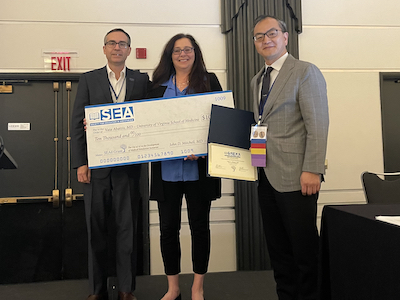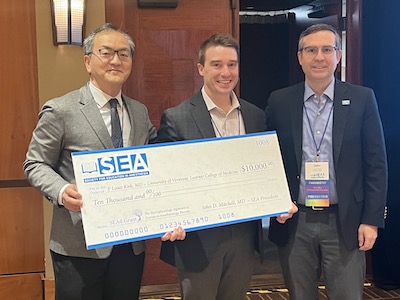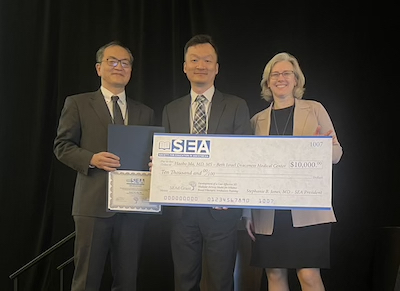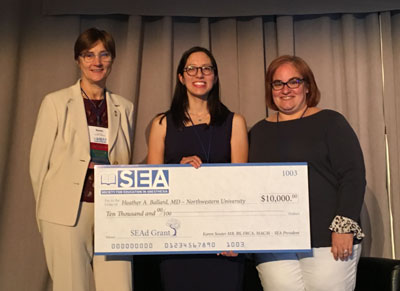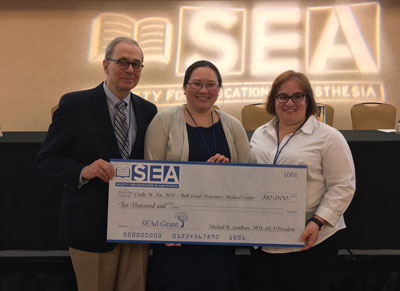SEAd Grant Recipients2025Validating a Novel Inventory to Assess Well-Being Influencers and Guide the Cultivation of Supportive Learning Environments in Anesthesiology TrainingKenneth Elliott Higgins III, M.D. This study aims to demonstrate generalizability of initial validity evidence for Well-Being Influencers Survey for Healthcare (WISH) specifically for trainees in anesthesiology. We hypothesize WISH will demonstrate robust validity and reliability across training programs in reflecting the presence and prominence of well-being influencers when administered in appropriate contexts with safeguards (e.g., anonymous responses and reassurances of confidentiality). 2024The Use of AI in the Development of Medical Simulation Scenarios
Vaia Abatzis, MD The intent of this study is to determine the utility of using AI (artificial intelligence) in the development of simulation scenarios. As the use of AI has increased, especially since the introduction of ChatGPT in 2022, we are curious if AI can be used effectively in simulation development. Faculty interested in developing new simulation scenarios find it is difficult to develop/implement simulations as they are frequently limited by the increasing demands of clinical duties. This results in many simulations not getting past the time-consuming initial development phase. This study will look at scenario development by AI compared to established scenarios in addition to the impact of AI in developing new scenarios. 2023The Neurophysiologic Signature of Distress in Anesthesiology Trainees
F Louis Kirk, MD The procedural learning environment is inherently stressful, and the success of the trainee depends on the ability of training programs to promote learning in the zone of proximal development (ZPD). The ZPD is the educational space between what the learner has mastered and what they need to master next. Learning in this space requires the learner to leave their comfort zone and is therefore stress-inducing. Though moderate levels of stress enhance memory formation and play a role in medical education, excess stress (e.g., distress) impedes learning. Currently, no study has investigated how distress leads to impaired learning and/or performance. Our goal is to characterize the neurophysiology of distress in anesthesiology residents using electroencephalography (EEG). 2022Development of a Cost-Effective 3D Modular Airway Model for Fiberoptic Intubation Training
Haobo Ma, MD, MS Fiberoptic intubation (FOI) is a critical airway management skill. Our goal is to improve skills acquisition in FOI learning by developing and validating a low-cost, 3D modular airway model for deliberate practice. We produced a prototype airway model using 3D printing (3DP) with interchangeable components that can generate exponential anatomic combinations. We hypothesize that 3DP’s affordability, diverse anatomic representations, and dimensionality will provide higher-quality and effective training, with reduced cognitive load for novices. Our aims are: Aim 1: To develop modular 3DP airway models for FOI maneuvers of varying difficulty levels Aim 2: To compare effectiveness of FOI training using 3DP models to manikin-based training Aim 3: To assess the impact of modular training on cognitive load and skills retention in trainees 2021Virtual Simulation Versus High-Fidelity Mannequin Simulation to Train Anesthesia ResidentsGianluca Bertolizio, MD, FRCSC Despite remarkable progress, pediatric anesthesia-related mortality remains 2 to 30 times higher than in adults. Non-technical skills rather than a lack of expertise were identified to be the main cause of errors in medicine, particularly in emergency situations. As a consequence, interactive computer-based sessions and high-fidelity simulation have been progressively integrated into pediatric training programs. The setup of a suitable simulation center, however, is expensive and requires space, logistical support and manpower. Virtual reality (VR) is a technological innovation that has been increasingly integrated into clinical practice and medical training. Comparing to the mannequin-based simulation, theoretical advantages of VR are the inherent highly immersive quality, the independent participation with no need of other participants, the ease of multiple repetitions, the lack of time or space constrains, and the reduced costs. Non-technical and operational skills appear to improve significantly after VR training. To date, information on the efficacy of VR in the anesthesia training are limited. The primary aim will be to compare the improvement of non-technical skills after one simulation session between VR and high-fidelity mannequin simulation (HFS). Secondary aims will be to compare the overall anesthesia resident non-technical skills performance between VR and HFS, and to determine confidence in the simulation training of each participant. 2020Using Anesthesiology Resident Confessions to Construct a Conceptual Model for Resident Professional Identity FormationMatthew F. Hirschfeld, MD Since first describing “Confessions” as used to ease transition to residency, it is now widely adopted within and outside our program. Sessions entail program leadership-moderated single class meetings to share anonymously submitted printed confessions which are assigned pain scores to help calibrate the tone of the discussion. We plan to extend pilot work by analyzing retrospective data and by gathering prospective data to enable the construction and validation of a conceptual model of themes impacting resident professional identity formation throughout training. Prospective data will be collected and analyzed for one year and includes (a) written confessions and associated pain scores and (b) semi-structured resident interviews. Confession sessions will be observed and interviews administered by a qualitative researcher. Both activities will be recorded and transcribed. Grounded theory will be used to construct a conceptual model of resident professional identity formation by coding confessions in three stages: open, axial, and selective. Triangulation of prospective and retrospective data will enhance trustworthiness. The concept of Community of Practice (CoP) will serve as the theoretical perspective for model creation. Output of this analysis will entail (a) the construct a conceptual model of themes impacting resident professional identity formation, (b) the identification of modifiable program characteristics that impact resident professional identity formation at various stages of training, and, (c) improved understanding of Confessions to foster resident professional identity formation in relation to the residents’ CoP. 2019The Effect of Simulation-based Mastery Learning on Pediatric Ultrasound-guided Vascular Access Performance
Heather A. Ballard, MD Pediatric vascular access is inherently challenging due to the small diameter of veins. As a result, children with difficult access may experience multiple cannulation attempts, resulting in increased anxiety, decreased parental satisfaction, and longer anesthetic exposure if performed under sedation. Ultrasound-guided intravenous catheter insertion (USGIV) has been shown to decrease the time to cannulation and increase success rates in children with difficult intravenous access. Though proficiency in USGIV insertion is a critical skill in pediatric anesthesia, there is no published curriculum. This lack of rigorous training leads to uneven skill acquisition and potentially worse clinical outcomes. Simulation-based mastery learning (SBML) is an extreme form of competency-based learning proven to improve clinical skills. In SBML, simulators are used to train learners until they meet a high predetermined level of skill. First, learners participate in a skill pre-test on a simulator. Next, they engage in deliberate practice. Lastly, they perform a skill post-test on a simulator and must meet or exceed a minimum passing score (MPS) before completion of training. Those who are unable to meet this score undergo further deliberate practice until they can meet the MPS. SBML has been successfully applied to clinical skills including Advanced Cardiac Life Support, central venous catheter insertion, and communication skills. However, there has been few studies of SBML translating to patient outcomes. Our hypothesis is that learners trained in this curriculum will have significantly better USGIV skills than those who are not trained. This will be demonstrated by performance on checklists and review of electronic medical record data (EMR). In this study, randomized blocks of pediatric anesthesia providers (attendings, fellows, residents) will be trained each month until everyone has been trained. By using a stepped wedge randomized controlled trial design, each learner’s intravenous attempts before being trained will act as the control, whereas the intravenous attempts after SBML training will act as the exposed. The USGIV curriculum consists of pre-test evaluation, video didactic, live demonstration, and deliberate practice with feedback using a partial task trainer. At a later time, participants are examined with a post-test and required to meet or exceed the MPS. The MPS was determined by a group of experts using the Mastery Angoff method. The pre/post-test checklist was developed using the modified Delphi technique. Every IV inserted by an anesthesia provider requires documentation in the EMR and includes the number of intravenous attempts, ultrasound use, and need for unplanned central line. We performed a pilot study on this curriculum with pediatric anesthesia fellows and certified registered nurse anesthetists. Our pilot data suggests that anesthesia providers who participate in SBML USGIV curriculum have superior skills compared to usual training as measured by improvements in pre- to post testing on the simulator. Therefore, we propose to implement this curriculum to all pediatric anesthesia providers to determine its impact on provider and patient outcomes. If our project is successful in improving patient outcomes, we hope to implement and disseminate our SBML curriculum in other health systems. Ballard HA, Hajduk J, Cheon EC, King MR, Barsuk JH. Clinical and demographic factors associated with pediatric difficult intravenous access in the operating room. Paediatr Anaesth. 2022 Jul;32(7):792-800. doi: 10.1111/pan.14438. Epub 2022 Mar 23. PMID: 35293066; PMCID: PMC9310763. 2018Working Memory Interruptions and Errors in Anesthesiology: A Randomized, Controlled, Simulation-Based Study
Ashley Szabo Eltorai, MD Anesthesiology requires the execution of numerous individual tasks with meticulous attention to detail, while simultaneously performing constant surveillance of the patient and operating room environment and immediately responding to any issues. When multiple tasks are pending, anesthesiologists rely upon working memory to ensure that all remain in queue and are accomplished accurately. “Working memory” refers to the combination of short-term memory and other processing mechanisms that enables the planning and execution of tasks. Though the duration of short-term memory is thought to be 15-30 seconds, items are retained longer, and even transferred to long-term memory, through rehearsal. If rehearsal of new information is actively prevented, then information rapidly escapes from memory. Since anesthesiologists are frequently subjected to interruptions in working memory as changes in patient condition and operating room environment arise continuously, minimizing these interruptions should be a paramount concern in the pursuit of quality improvement. For an anesthesiology resident still in training, the impact of working memory interruptions may be especially substantial, so modifying the operating room environment accordingly may be especially critical for the optimization of both resident education and patient safety. This randomized, controlled, simulation-based study involves subjects of all anesthesiology training levels, from residents to fellows to junior and senior faculty. During an orthopedic surgery case occurring in a simulated operating room, subjects are asked by the surgeon to administer a certain bolus and infusion dose of tranexamic acid, and the primary outcome measure is whether or not the correct dose is both drawn up into the fluid bag and programmed into the infusion pump, plus the amount of time required. The independent variable is the presence of distracting scenarios pertaining to equipment unavailability, activating music, and surgeon complaints communicated to the anesthesiologist in a manner consistent with anger. In the control scenario, none of the above distractors will exist. Subjects will serve as their own controls (randomized counterbalance design), since inter-individual variability in cognitive processing is substantial. The primary hypothesis is that the presence of distractors will be associated with a significantly higher error rate and higher amount of time required for those who do successfully draw up and administer the correct dose of tranexamic acid, and that the difference will be greatest among junior anesthesiology residents, thus substantiating the importance of minimizing environmental distractors for trainees in the operating room. 2017Project Pandemic – Efficient and Effective Teamwork and Communication Skills Training Using a Tabletop Game
Cindy M. Ku, MD High quality teamwork is critical throughout medicine, particularly in fast-paced, high-stakes perioperative environments. High-fidelity simulation has been the predominant education modality for nontechnical skills and team training, within both individual specialties and interdisciplinary health professional education. However, broad utilization of high-fidelity simulation has significant economic, labor and facility barriers. The use of low-fidelity collaborative board games for teaching nontechnical skills has been reported in medical education. We hypothesize that essential nontechnical skills, such as communication and teamwork, can be efficiently and effectively developed in anesthesia trainees using a game-based education intervention in a nonclinical, classroom setting. This study takes a mixed methods approach to assess and compare the impact of game-based intervention and simulation training on building teamwork skills. The approach consists of the following: 1) trainees’ self-assessment preand post-intervention (game or simulation); 2) observers’ ratings of team interactions on recorded video; 3) focus groups of trainees after each intervention; and 4) interval clinical observations of trainees in the clinical setting. Using previously validated self-assessment and observer instruments along with structured debriefing and focus group sessions, this mixed methods or multipronged approach allows for a comprehensive view of how game-based intervention and simulation training compare in their effectiveness on teaching teamwork skills. 2016Residents as Teachers: Effect of a Patient Education Strategy on Resident Self-Efficacy and Maternal Outcomes (The EDUCATE Study)Katherine "Grace" Lim, MD Resident physician anesthesiologists have lifelong roles as teachers and leaders. Therefore, the importance of effectively training our residents how to teach is apparent. Furthermore, while much of the focus of residents as teachers is centered on peer and medical student education, the resident physician’s role in educating their patients is often overlooked. Patient education is important because it improves compliance with treatment plans, has been shown to improve patient outcomes and satisfaction, and attenuates malpractice risk. For anesthesiology residents, communication with patients is particularly highlighted on the obstetric anesthesiology subspecialty rotation. Here, the initiation and management of labor epidural analgesia requires that an anesthesiology resident be adept at establishing and managing patient expectations, and at teaching patients optimal pain management strategies, all within the challenging setting of childbirth. In this context, we propose a prospective, randomized control study in which we: 1) train anesthesiology residents on their subspecialty obstetrical anesthesia rotation how to educate patients on the optimal use of patient-controlled labor epidural analgesia, and the expectations thereof; 2) measure the effect of this teaching intervention on educational outcomes, including resident self-efficacy for patient education; and 3) measure the effect of this teaching intervention on clinical outcomes, including total local anesthetic consumption, patient satisfaction, and maternal symptoms of psychological stress. Lim G, Krohner RG, Metro DG, Rosario BL, Jeong JH, Sakai T. Low-Fidelity Haptic Simulation Versus Mental Imagery Training for Epidural Anesthesia Technical Achievement in Novice Anesthesiology Residents: A Randomized Comparative Study. Anesth Analg. 2016 May;122(5):1516-23. doi: 10.1213/ANE.0000000000001260. PMID: 27007077; PMCID: PMC4840058. |


